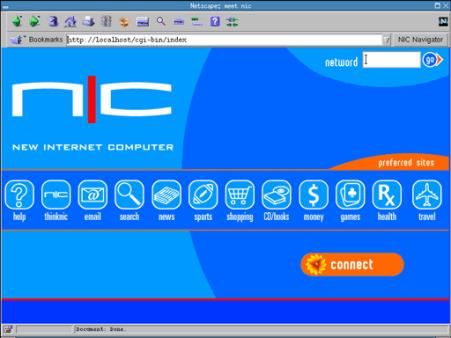Hacking Ellison’s NIC (Part 2)
Jun 8, 1997 — by Rick Lehrbaum — from the LinuxDevices Archive — viewsMaking the NIC do stuff
The provided application software mainly consists of a customized version of Netscape, which essentially comprises the NIC's user interface. Customized toolbar buttons provide access to a few internal games and configuration screens (see photo).

The NIC's internal “home page”
In addition to Netscape, there is also a supplied VNC viewer, an IRC client, and a Windows Citrix client. Shell access to other computers is provided by telnet and ssh clients (but no telnet or ssh server support is provided, so you cannot open a shell session on the NIC itself). You can also use the NIC as a remote X terminal by using xhost.
In general, the NIC's designers did a good job of hiding (or restricting access to, depending on your point of view) the Linux core of the appliance. In fact, the average user is unlikely to encounter anything other than the Netscape environment.
Consequently, I found it remarkably difficult to escape from that environment using the supplied software. This may be frustrating to a Linux user wishing to look under the hood, but on the other hand it's a good thing for those needing a reliable, dedicated “Internet appliance”.
Cost/architectural tradeoffs
It will be interesting to see whether or not customers embrace this interesting new Internet appliance. In functionality and flexibility, the NIC falls midway between a personal computer, with the flexibility (and accompanying configuration and maintenance responsibilities), and perhaps a TV, which requires no effort to use but only does what its manufacturer designs into it.
In general, the NIC's approach can work, but only if the company chooses the right point on the usability/flexibility scale. In my opinion, the current NIC software seems to sacrifice more flexibility than necessary.
For example, no mail client is provided. Instead, you are required to use web-based mail services — the NIC provides a preconfigured link to Yahoo's mail service. As a result, you can't make use of your preexisting mail service. This limitation is sure to be noticed by many average users.
The decision to not provide a built-in mail client makes some sense from a system design point of view, since a device with only 4 MB of local storage (in Flash memory) can't store much mail history, especially attachments. However, a good mail client is important to any Internet user, so there really ought to have been more of an effort to provide one.
Netscape's mail client, perhaps with some tools to allow users to make intelligent decisions on which messages to save and which to discard, would seem to appeal to a broader user base. As it is, the NIC is quite unusable by anyone in my household, none of whom would be willing to switch their mail to an exclusively web-based service.
Clearly, the NIC is meant to be used as a true “thin client”, with all substantial applications and data located elsewhere (generally on the Internet). The question is: will that style of computing be acceptable to enough users to make the NIC successful? That remains to be seen.
All of which leads me to the subject of . . .
Story navigation . . .
- Part 1: Software as a growing percentage of system costs
- Part 2: Making the NIC do stuff
- Part 3: First hack attempt
- Part 4: Poking around inside the NIC
- Part 5: The verdict?
This article was originally published on LinuxDevices.com and has been donated to the open source community by QuinStreet Inc. Please visit LinuxToday.com for up-to-date news and articles about Linux and open source.